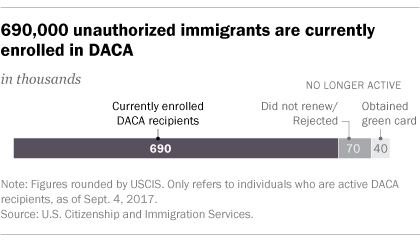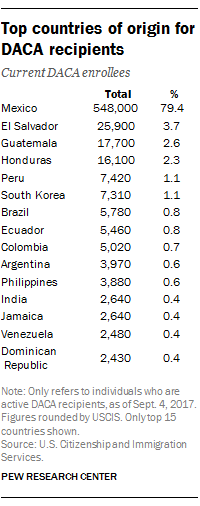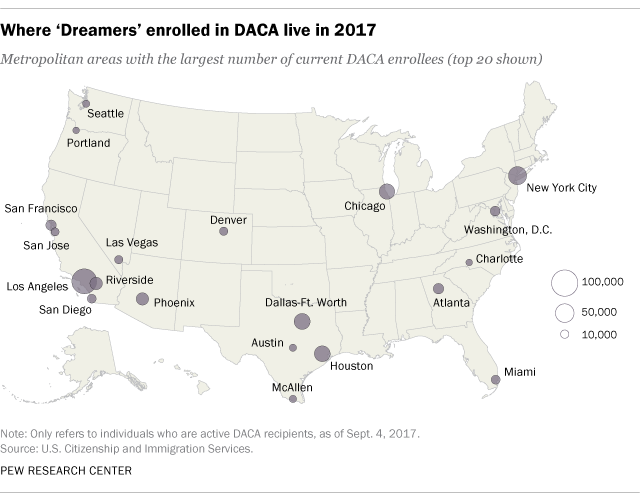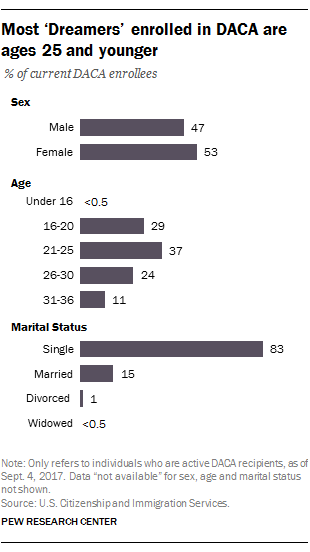Approximately 800,000 young unauthorized immigrants have received work permits and protection from deportation through the Deferred Action for Childhood Arrivals program, or DACA, since its creation five years ago. And nearly 690,000 of these immigrants are currently enrolled in the program, according to new data from U.S. Citizenship and Immigration Services.
The program’s future is uncertain after President Donald Trump’s recent announcement of plans to phase it out. The U.S. government is not accepting new DACA applications and will stop accepting renewal applications on Oct. 5. Those currently enrolled in the program retain their benefits, which last for a total of two years.
Trump has urged Congress to pass legislation by March 2018 that would give legal status to unauthorized immigrants enrolled in DACA, and some members of Congress have said they plan to propose legislation along those lines. (DACA enrollees whose benefits expire after March 5, 2018, will be the first to be dropped from the program.)
In the new data, U.S. Citizenship and Immigration Services has for the first time released detailed demographic information about those currently enrolled in DACA, a group sometimes called “Dreamers.” Here are some key facts about these individuals, based on the new data.

About 690,000 unauthorized immigrants were enrolled in DACA as of Sept. 4. Although roughly 800,000 unauthorized immigrants have ever received benefits through DACA, about 110,000 of this group are no longer enrolled in the program. About 70,000 former DACA participants did not renew their benefits or had their renewal applications denied. Another 40,000 have adjusted their legal status and obtained green cards, which grant lawful permanent residence. (Some unauthorized immigrants in the U.S. can obtain legal status by marrying an American citizen or lawful permanent resident, obtaining asylum, or receiving certain types of visas such as those given to victims of a crime, among other ways.)
To qualify for DACA, enrollees must meet certain conditions, such as being enrolled in high school or having a high school diploma or GED equivalent, and not being convicted of a felony, significant misdemeanor, or three or more other misdemeanors.

Current DACA recipients come from around the world, but more than nine-in-ten were born in Latin America. Mexico is by far the top country of origin for active DACA recipients (548,000), followed by El Salvador (25,900), Guatemala (17,700) and Honduras (16,100). A significant number of DACA recipients also hail from Peru (7,420), South Korea (7,310), Brazil (5,780), Ecuador (5,460), Colombia (5,020) and Argentina (3,970).
By region, almost all current DACA recipients were born in Mexico or Central or South America (648,430, or 94%). Another 18,940 (3%) were born in Asia, followed by the Caribbean (8,350), Europe (5,190) and Africa (4,240).
Three-quarters of DACA recipients live in 20 U.S. metro areas. With 89,900 DACA recipients, the Los Angeles-Long Beach-Anaheim metropolitan area had the largest number of active enrollees as of Sept. 4. That was nearly twice as many enrollees as the next largest metro area, New York-Newark-Jersey City (47,200). Other top metro areas include Dallas-Fort Worth-Arlington (36,700), Houston-The Woodlands-Sugar Land (35,800) and Chicago-Naperville-Elgin (34,100). The top metro areas of current DACA recipients are similar to those of the nation’s unauthorized immigrant population as a whole.
Nearly half (45%) of current DACA recipients live in just two states: California (29%) and Texas (16%). Illinois (5%), New York (5%), Florida (4%) and Arizona (4%) also have significant populations of active DACA recipients.


Two-thirds of DACA recipients are ages 25 or younger, and a majority are women. Women make up a slight majority (53%) of active DACA recipients, while 47% are men, according to the tabulations from U.S. Citizenship and Immigration Services.
The average age of “Dreamers” enrolled in DACA is 24 years old. Those 25 and younger make up two-thirds of active DACA recipients – 29% are ages 16-20 and 37% are ages 21-25. About a quarter (24%) are ages 26-30, while one-in-ten (11%) are ages 31-36. (No DACA recipients are older than 36 because the program required applicants to have entered the U.S. before their 16th birthday and have been under the age of 31 as of June 15, 2012.)
Most current DACA recipients (83%) were unmarried at the time of their most recent application. By contrast, 15% were married and 1% were divorced. (Less than 1% were widowed.)
Related posts:
DACA has shielded nearly 790,000 young unauthorized immigrants from deportation
20 metro areas are home to six-in-ten unauthorized immigrants in U.S.
